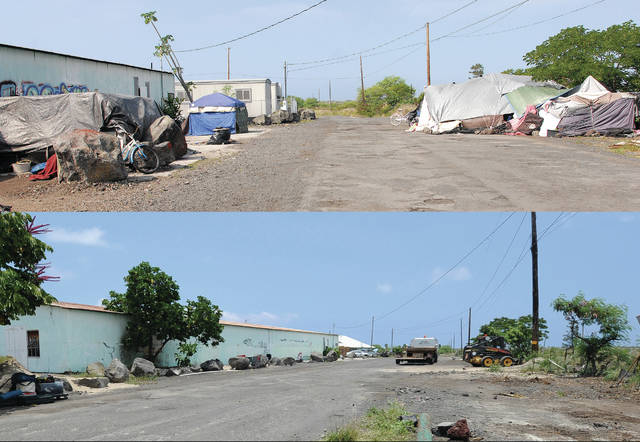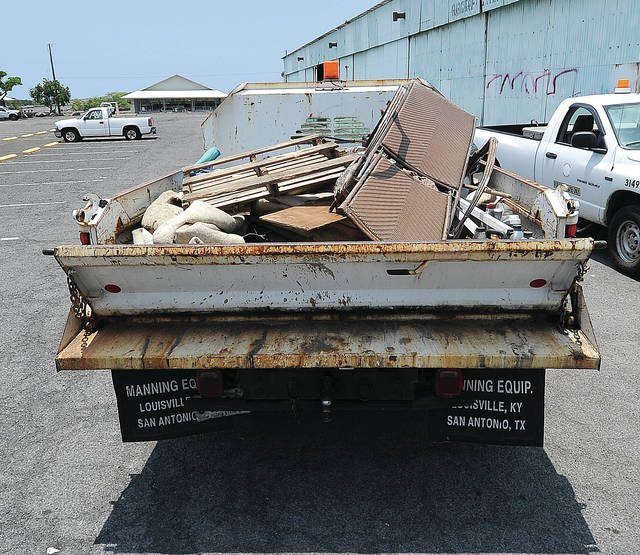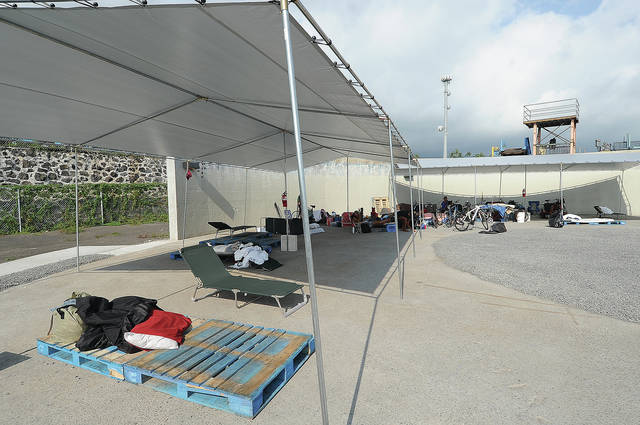County eyes permanent homeless location
KAILUA-KONA — Mayor Harry Kim declared a state of emergency Tuesday to pave the way for the relocation of several homeless individuals residing at the Old Airport Park who had been told they must vacate the premises by that date.
But the declaration — which allows the county to subvert its own zoning, building, and fire codes — had nothing to do with clearing a path for 20 homeless who now reside on cots under temporary canopies at the Hale Kikaha shelter adjacent to the Friendly Place in the Old Kona Industrial Area.
Kim said Wednesday if he’d needed a declaration to shelter almost two dozen former residents of Old A on the same lot the county used for 23 micro housing units now occupied by formerly chronic homeless, he would have made the declaration weeks ago.
Instead, the mayor made the move to clear the way for a potential permanent relocation site on state-owned land associated with the $52 million Kamakana Villages affordable housing developments.
Kim made his choice because he saw an opportunity to expedite the process of possibly securing a permanent location for the homeless.
That’s because the mayor learned late last week that the state doesn’t plan to pursue further development on its 270-acre plot off Ane Keohokalole Highway beyond the 170 affordable housing units it’s already constructed, into which selected tenants will begin settling this fall.
“I saw an opportunity and I wanted to grab it,” Kim said. “I want to have our program become a part of that program, and that’s the reason for the emergency declaration. I have to be sure I abide by the rules and regulations in using any piece of property, so when you declare a state of emergency, it allows you to bypass certain (processes).”
Gov. David Ige used a similar proclamation in October of 2015 to allow for the rapid reallocation of funds to create and bolster homelessness initiatives across Hawaii, which led to Hawaii County’s micro housing units.
Kim said the strategy will allow him to bypass lengthy bid processes and potentially move the homeless relocated to Hale Kikaha to the new site as quickly as possible. He added Ige has already granted the county a verbal OK to use part of the land because the state’s future plans for it no longer exist.
Roy Takemoto, executive assistant to Kim, said the Hale Kikaha relocation is part one of a three-step plan. He referred to it as “very temporary” and said the administration’s goal is to move forward on a new location, likely Kamakana, within two months.
Homeless would live on a small parcel of the acreage as it evolves.
“The total area we’re looking at is a portion that would consist of 5 acres — something we can go in very quickly, clear the land, maybe set up tents again but in a more spacious and planned layout,” Takemoto said.
Over the last two weeks, HOPE Services and the Hawaii County Office of Housing and Community Development identified 68 homeless living at the Old Airport Park. They were able to house 17 of them. Another 20 were sent to Hale Kikaha.
HOPE and the county used the Housing First vulnerability tool to determine the most vulnerable of the population, who were prioritized.
But of the 68 individuals ushered out of the park by Wednesday’s deadline, 62 expressed interest in moving indoors. That left roughly 25 homeless with nowhere to turn.
Takemoto said if a site at Kamakana materializes, not only will it be able to support the 20 people at Hale Kikaha and the 25 homeless left on the street, but it could accommodate “all those other homeless all over Kailua-Kona.”
The site would only be tents at first, along with showers, portable toilets and a drinking water source. But it would develop quickly into a full-fledged permanent re-housing project equipped with structures and a host of social services.
But if Kim can obtain the hundreds of acres around Kamakana Villages, he doesn’t plan to stop progress with a five-acre plot for Kona’s homeless.
The mayor’s vision includes building out more affordable housing, and potentially market housing and mixed-use lands, similar to the state’s plan for later phases of its now defunct plan.
He said Kamakana is an option with more open-ended possibilities than a potential land swap with the Queen Liliuokalani Trust, which had been discussed extensively before Kamakana opened up.
The land swap, involving a 24-acre parcel above the intersection of Palani Road and Henry Street is still on the table, but the administration is currently focused on procuring the Kamakana site, on which development could proceed more quickly and on a grander scale.
How the county would pay for it remains a question, but Takemoto said some community members and developers — like Kennedy Wilson, which developed the Kohanaiki Golf and Ocean Club — have offered financial assistance, as well as their expertise. Other sources of state and federal money would also be sought.
“If the county assumes control of Kamakana, we would look to experienced developers who know how to tap into all those different pots of money,” Takemoto said.
The transfer of the land around Kamakana also has yet to be ironed out.
“I’m not sure what the conveyance mechanism from the state would be,” Takemoto explained, “but it hopefully wouldn’t be something that the county would have to pay for.”
Mattson Davis, former CEO of Kona Brewing Company, said relocating homeless encampments out of the Old Kona Industrial Area would benefit everyone involved.
More than a new brewery, future development right outside Hale Kikaha encompass what Davis called a “makers market,” which will consist of new businesses from food and beverage concepts to distilleries and bakeries, all producing and selling their wares.
New parking, store fronts and economic drivers for Kona are all part of an economic vision to create what Davis called the new “downtown Kona.” Thus, he and others with interests in the area are concerned about homeless parking cars or setting up camps there, as they’ve done in previous months.
To Davis, that’s a worse situation than the Old Airport Park overflowing with homeless.
“The location is not sustainable (for a homeless living site), meaning it can’t survive long term because it can’t grow and it doesn’t belong in the middle of what soon will become Kona downtown,” Davis said. “We’re just keeping our eye on it at this point.”





